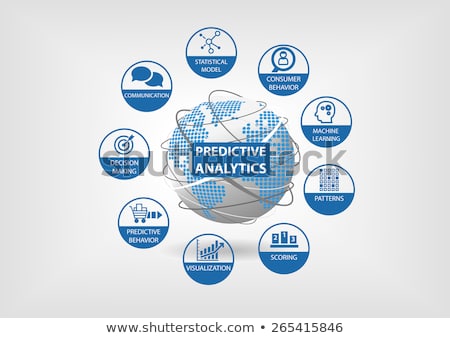The Next Generation of Data Science
Quite literally, I am stunned.
I have just completed my survey of data (from articles, blogs, white papers, university websites, curated tech websites, and research papers all available online) about predictive analytics.
And I have a reason to believe that we are standing on the brink of a revolution that will transform everything we know about data science and predictive analytics.
But before we go there, you need to know: why the hype about predictive analytics? What is predictive analytics?
Let’s cover that first.
Importance of Predictive Analytics

By PhotoMix Ltd
According to Wikipedia:
Predictive analytics is an area of statistics that deals with extracting information from data and using it to predict trends and behavior patterns. The enhancement of predictive web analytics calculates statistical probabilities of future events online. Predictive analytics statistical techniques include data modeling, machine learning, AI, deep learning algorithms and data mining.
Predictive analytics is why every business wants data scientists. Analytics is not just about answering questions, it is also about finding the right questions to answer. The applications for this field are many, nearly every human endeavor can be listed in the excerpt from Wikipedia that follows listing the applications of predictive analytics:
From Wikipedia:
Predictive analytics is used in actuarial science, marketing, financial services, insurance, telecommunications, retail, travel, mobility, healthcare, child protection, pharmaceuticals, capacity planning, social networking, and a multitude of numerous other fields ranging from the military to online shopping websites, Internet of Things (IoT), and advertising.
In a very real sense, predictive analytics means applying data science models to given scenarios that forecast or generate a score of the likelihood of an event occurring. The data generated today is so voluminous that experts estimate that less than 1% is actually used for analysis, optimization, and prediction. In the case of Big Data, that estimate falls to 0.01% or less.
Common Example Use-Cases of Predictive Analytics

Components of Predictive Analytics
A skilled data scientist can utilize the prediction scores to optimize and improve the profit margin of a business or a company by a massive amount. For example:
- If you buy a book for children on the Amazon website, the website identifies that you have an interest in that author and that genre and shows you more books similar to the one you just browsed or purchased.
- YouTube also has a very similar algorithm behind its video suggestions when you view a particular video. The site identifies (or rather, the analytics algorithms running on the site identifies) more videos that you would enjoy watching based upon what you are watching now. In ML, this is called a recommender system.
- Netflix is another famous example where recommender systems play a massive role in the suggestions for ‘shows you may like’ section, and the recommendations are well-known for their accuracy in most cases
- Google AdWords (text ads at the top of every Google Search) that are displayed is another example of a machine learning algorithm whose usage can be classified under predictive analytics.
- Departmental stores often optimize products so that common groups are easy to find. For example, the fresh fruits and vegetables would be close to the health foods supplements and diet control foods that weight-watchers commonly use. Coffee/tea/milk and biscuits/rusks make another possible grouping. You might think this is trivial, but department stores have recorded up to 20% increase in sales when such optimal grouping and placement was performed – again, through a form of analytics.
- Bank loans and home loans are often approved with the credit scores of a customer. How is that calculated? An expert system of rules, classification, and extrapolation of existing patterns – you guessed it – using predictive analytics.
- Allocating budgets in a company to maximize the total profit in the upcoming year is predictive analytics. This is simple at a startup, but imagine the situation in a company like Google, with thousands of departments and employees, all clamoring for funding. Predictive Analytics is the way to go in this case as well.
- IoT (Internet of Things) smart devices are one of the most promising applications of predictive analytics. It will not be too long before the sensor data from aircraft parts use predictive analytics to tell its operators that it has a high likelihood of failure. Ditto for cars, refrigerators, military equipment, military infrastructure and aircraft, anything that uses IoT (which is nearly every embedded processing device available in the 21st century).
- Fraud detection, malware detection, hacker intrusion detection, cryptocurrency hacking, and cryptocurrency theft are all ideal use cases for predictive analytics. In this case, the ML system detects anomalous behavior on an interface used by the hackers and cybercriminals to identify when a theft or a fraud is taking place, has taken place, or will take place in the future. Obviously, this is a dream come true for law enforcement agencies.
So now you know what predictive analytics is and what it can do. Now let’s come to the revolutionary new technology.
Meet Endor – The ‘Social Physics’ Phenomenon

End-to-End Predictive Analytics Product – for non-tech users!
In a remarkable first, a research team at MIT, USA have created a new science called social physics, or sociophysics. Now, much about this field is deliberately kept highly confidential, because of its massive disruptive power as far as data science is concerned, especially predictive analytics. The only requirement of this science is that the system being modeled has to be a human-interaction based environment. To keep the discussion simple, we shall explain the entire system in points.
- All systems in which human beings are involved follow scientific laws.
- These laws have been identified, verified experimentally and derived scientifically.
- Bylaws we mean equations, such as (just an example) Newton’s second law: F = m.a (Force equals mass times acceleration)
- These equations establish laws of invariance – that are the same regardless of which human-interaction system is being modeled.
- Hence the term social physics – like Maxwell’s laws of electromagnetism or Newton’s theory of gravitation, these laws are a new discovery that are universal as long as the agents interacting in the system are humans.
- The invariance and universality of these laws have two important consequences:
- The need for large amounts of data disappears – Because of the laws, many of the predictive capacities of the model can be obtained with a minimal amount of data. Hence small companies now have the power to use analytics that was mostly used by the FAMGA (Facebook, Amazon, Microsoft, Google, Apple) set of companies since they were the only ones with the money to maintain Big Data warehouses and data lakes.
- There is no need for data cleaning. Since the model being used is canonical, it is independent of data problems like outliers, missing data, nonsense data, unavailable data, and data corruption. This is due to the orthogonality of the model ( a Knowledge Sphere) being constructed and the data available.
- Performance is superior to deep learning, Google TensorFlow, Python, R, Julia, PyTorch, and scikit-learn. Consistently, the model has outscored the latter models in Kaggle competitions, without any data pre-processing or data preparation and cleansing!
- Data being orthogonal to interpretation and manipulation means that encrypted data can be used as-is. There is no need to decrypt encrypted data to perform a data science task or experiment. This is significant because the independence of the model functioning even for encrypted data opens the door to blockchain technology and blockchain data to be used in standard data science tasks. Furthermore, this allows hashing techniques to be used to hide confidential data and perform the data mining task without any knowledge of what the data indicates.
Are You Serious?

That’s a valid question given these claims! And that is why I recommend everyone who has the slightest or smallest interest in data science to visit and completely read and explore the following links:
- https://www.endor.com
- https://www.endor.com/white-paper
- http://socialphysics.media.mit.edu/
- https://en.wikipedia.org/wiki/Social_physics
Now when I say completely read, I mean completely read. Visit every section and read every bit of text that is available on the three sites above. You will soon understand why this is such a revolutionary idea.
- https://ssir.org/book_reviews/entry/going_with_the_idea_flow#
- https://www.datanami.com/2014/05/21/social-physics-harnesses-big-da…
These links above are articles about the social physics book and about the science of sociophysics in general.
For more details, please visit the following articles on Medium. These further document Endor.coin, a cryptocurrency built around the idea of sharing data with the public and getting paid for using the system and usage of your data. Preferably, read all, if busy, at least read Article No, 1.
- https://medium.com/endor/ama-session-with-prof-alex-sandy-pentland
- https://medium.com/endor/endor-token-distribution
- https://medium.com/endor/https-medium-com-endor-paradigm-shift-ai-p…
- https://medium.com/endor/unleash-the-power-of-your-data
Operation of the Endor System
Upon every data set, the first action performed by the Endor Analytics Platform is clustering, also popularly known as automatic classification. Endor constructs what is known as a Knowledge Sphere, a canonical representation of the data set which can be constructed even with 10% of the data volume needed for the same project when deep learning was used.
Creation of the Knowledge Sphere takes 1-4 hours for a billion records dataset (which is pretty standard these days).
Now an explanation of the mathematics behind social physics is beyond our scope, but I will include the change in the data science process when the Endor platform was compared to a deep learning system built to solve the same problem the traditional way (with a 6-figure salary expert data scientist).
An edited excerpt from https://www.endor.com/white-paper:
From Appendix A: Social Physics Explained, Section 3.1, pages 28-34 (some material not included):
Prediction Demonstration using the Endor System:
Data:
The data that was used in this example originated from a retail financial investment platform
and contained the entire investment transactions of members of an investment community.
The data was anonymized and made public for research purposes at MIT (the data can be
shared upon request).Summary of the dataset:
– 7 days of data
– 3,719,023 rows
– 178,266 unique usersAutomatic Clusters Extraction:
Upon first analysis of the data the Endor system detects and extracts “behavioral clusters” – groups of
users whose data dynamics violates the mathematical invariances of the Social Physics. These clusters
are based on all the columns of the data, but is limited only to the last 7 days – as this is the data that
was provided to the system as input.Behavioural Clusters Summary
Number of clusters:268,218
Clusters sizes: 62 (Mean), 15 (Median), 52508 (Max), 5 (Min)
Clusters per user:164 (Mean), 118 (Median), 703 (Max), 2 (Min)
Users in clusters: 102,770 out of the 178,266 users
Records per user: 6 (Median), 33 (Mean): applies only to users in clustersPrediction Queries
The following prediction queries were defined:
1. New users to become “whales”: users who joined in the last 2 weeks that will generate at least
$500 in commission in the next 90 days
2. Reducing activity : users who were active in the last week that will reduce activity by 50% in the
next 30 days (but will not churn, and will still continue trading)
3. Churn in “whales”: currently active “whales” (as defined by their activity during the last 90 days),
who were active in the past week, to become inactive for the next 30 days
4. Will trade in Apple share for the first time: users who had never invested in Apple share, and
would buy it for the first time in the coming 30 daysKnowledge Sphere Manifestation of Queries
It is again important to note that the definition of the search queries is completely orthogonal to the
extraction of behavioral clusters and the generation of the Knowledge Sphere, which was done
independently of the queries definition.Therefore, it is interesting to analyze the manifestation of the queries in the clusters detected by the system: Do the clusters contain information that is relevant to the definition of the queries, despite the fact that:
1. The clusters were extracted in a fully automatic way, using no semantic information about the
data, and –2. The queries were defined after the clusters were extracted, and did not affect this process.
This analysis is done by measuring the number of clusters that contain a very high concentration of
“samples”; In other words, by looking for clusters that contain “many more examples than statistically
expected”.A high number of such clusters (provided that it is significantly higher than the amount
received when randomly sampling the same population) proves the ability of this process to extract
valuable relevant semantic insights in a fully automatic way.Comparison to Google TensorFlow
In this section a comparison between prediction process of the Endor system and Google’s
TensorFlow is presented. It is important to note that TensorFlow, like any other Deep Learning library,
faces some difficulties when dealing with data similar to the one under discussion:1. An extremely uneven distribution of the number of records per user requires some canonization
of the data, which in turn requires:2. Some manual work, done by an individual who has at least some understanding of data
science.3. Some understanding of the semantics of the data, that requires an investment of time, as
well as access to the owner or provider of the data4. A single-class classification, using an extremely uneven distribution of positive vs. negative
samples, tends to lead to the overfitting of the results and require some non-trivial maneuvering.This again necessitates the involvement of an expert in Deep Learning (unlike the Endor system
which can be used by Business, Product or Marketing experts, with no perquisites in Machine
Learning or Data Science).Traditional Methods
An expert in Deep Learning spent 2 weeks crafting a solution that would be based
on TensorFlow and has sufficient expertise to be able to handle the data. The solution that was created
used the following auxiliary techniques:1.Trimming the data sequence to 200 records per customer, and padding the streams for users
who have less than 200 records with neutral records.2.Creating 200 training sets, each having 1,000 customers (50% known positive labels, 50%
unknown) and then using these training sets to train the model.3.Using sequence classification (RNN with 128 LSTMs) with 2 output neurons (positive,
negative), with the overall result being the difference between the scores of the two.Observations (all statistics available in the white paper – and it’s stunning)
1.Endor outperforms Tensor Flow in 3 out of 4 queries, and results in the same accuracy in the 4th
.
2.The superiority of Endor is increasingly evident as the task becomes “more difficult” – focusing on
the top-100 rather than the top-500.3.There is a clear distinction between “less dynamic queries” (becoming a whale, churn, reduce
activity” – for which static signals should likely be easier to detect) than the “Who will trade in
Apple for the first time” query, which are (a) more dynamic, and (b) have a very low baseline, such
that for the latter, Endor is 10x times more accurate!4.As previously mentioned – the Tensor Flow results illustrated here employ 2 weeks of manual
improvements done by a Deep Learning expert, whereas the Endor results are 100% automatic and the entire prediction process in Endor took 4 hours.
Clearly, the path going forward for predictive analytics and data science is Endor, Endor, and Endor again!
Predictions for the Future
Personally, one thing has me sold – the robustness of the Endor system to handle noise and missing data. Earlier, this was the biggest bane of the data scientist in most companies (when data engineers are not available). 90% of the time of a professional data scientist would go into data cleaning and data preprocessing since our ML models were acutely sensitive to noise. This is the first solution that has eliminated this ‘grunt’ level work from data science completely.
The second prediction: the Endor system works upon principles of human interaction dynamics. My intuition tells me that data collected at random has its own dynamical systems that appear clearly to experts in complexity theory. I am completely certain that just as this tool developed a prediction tool with human society dynamical laws, data collected in general has its own laws of invariance. And the first person to identify these laws and build another Endor-style platform on them will be at the top of the data science pyramid – the alpha unicorn.
Final prediction – democratizing data science means that now data scientists are not required to have six-figure salaries. The success of the Endor platform means that anyone can perform advanced data science without resorting to TensorFlow, Python, R, Anaconda, etc. This platform will completely disrupt the entire data science technological sector. The first people to master it and build upon it to formalize the rules of invariance in the case of general data dynamics will for sure make a killing.
It is an exciting time to be a data science researcher!
Data Science is a broad field and it would require quite a few things to learn to master all these skills.
Dimensionless has several resources to get started with.
